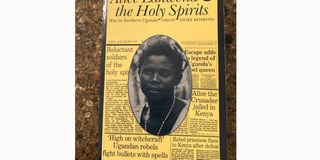Prime
Revisiting the myth, legend of Lakwena

What you need to know:
History. On May 25, 1985, Alice Auma, a young Acholi woman working as a fish seller at a place called Opit in northern Uganda, converted to Catholicism. Thereupon, the Christian spirit of an Italian, Lakwena, took violent possession of her.
She could not hear or speak, she was mute. So her father, Severino Lukoya, a catechist, sought help.
So he and Alice travelled to Paraa National Park, to a site on the Nile called Wang Jok where she disappeared and was not seen for 40 days.
While at Paraa, it is said that she held judgment over parts of animate and inanimate nature. The water, the wild animals and the mountains proved their innocence. Then they blamed the sinners with “two legs” for the evil in Uganda.
They thus asked the Lakwena to struggle against these evil doers and provided water and later stones for this undertaking.
This is the origin story of how this simple lady, Alice, was to raise an army in the name of the Lakwena called the Holy Spirit Mobile Forces (HSMF).
She waged a war against this perceived evil, not only an external enemy represented by the National Resistance Army (NRA), but internal enemies in the form of “impure” soldiers, witches, and sorcerers.
Alice Lakwena & the Holy Spirits: War in Northern Uganda 1986-97 tells this story as it also summons to its pages the age-old joust between the metaphysical and the physical.
The Lakwena
Lakwena was the spirit of an Italian, a captain who died at an advanced age near Murchison Falls during the Second World War. He reportedly drowned in the Nile to rise again as Supreme Commander and Chairman of the HSMF with Alice as his spirit medium.
Although he was the central spirit to have possessed Alice, she was also possessed by other spirits who helped command the HSMF. The HSMF had three companies, outside of the headquarters company, commanded by spirits such as Wrong Element. He was from the USA and spoke English with a thick American accent. He commanded A Company.
Then there was Franko, a spirit from Zaire (known today as the Democratic Republic of the Congo). He Commanded C Company.
Then there was Ching Poh who was a spirit from China or Korea. He commanded B Company and was largely responsible for the stone grenades.
There were also lesser spirits such as Nyaker, Miriam and Jeremiah who would variously deputise the major spirits or play a role in exorcising evil spirits and curing physical ailments, among other activities.
The Army
Apart from thousands of HSMF fighters, 140,000 spirits, bees, snakes, rivers and rocks of mountains joined the ranks of the Lakwena. Water from the rivers was used to heal, to “cool” the enemy weapons. Water was heralded as the “first born child of God.”
To conduct a successful war, the HSMF had to be bound by the discipline which holds armies together and binds them to a vision which choreographs their war footing with lock-step togetherness. This discipline was circumscribed by 20 Holy Spirit Safety Precautions as regaled to us by HSMF soldier and intellectual, Micheal Ocan:
-Thou shall not carry any walking stick in the battlefield
-Thou shall not kill prisoners of war
-Thou shall not kill snakes of any kind
-Thou shall have two testicles, neither more nor less.
Regarding the immunity of snakes from HSMF aggression, they were enlisted along with the rest of nature to wage war against evil.
According to Ocan, the chief chronicler of the HSMF, “the movement is centred on the Lakwena himself, who is also the Chairman of the Movement. He is represented by the Commander of the Forces (CF), in the military wing. The office CF is occupied through elections by all the soldiers, having ensured that the minimum educational requirement has been met by the candidates. The candidates must have attained basic training.”
Regional war
The HSMF started in Acholi before spreading to Lango, Teso and Busoga. It was truly an inter-ethnic rebel group. When marching on Kampala, it proved to be an effective fighting force, too. Since it was a war waged against what was perceived as evil, the war itself was deemed part of the process of cleansing the nation.
The Lakwena was not a warmonger; he was a retributive and redemptive force using war to achieve a new and better society.
The HSMF were thus an army for spiritual renewal.
As they stood erect under NRA fire while singing “Jesus has died, Jesus has risen, Jesus will come again”, they were smeared with Shea butter oil (moyaa in Acholi) and ochre (pala in Acholi) to render themselves bulletproof.
Despite how bizarre this sounds, they drove the decidedly superior NRA out of several battlefields, including Lagile in November 1986 and harvested large amounts of ammunition and arms therefrom. They also put the NRA to flight at Pajule in December 1986. Then in January 1987, at Arum, the NRA lost 24 soldiers and again took to its heels.
The HSMF suffered heavy casualties too at Corner Kilak and other battlegrounds because of its unconventional reliance on the elements to do battle with the Museveni regime.
It should be noted, however, that these methods of war worked best when believed by the HSMF soldiers and the NRA themselves.
Title: Alice Lakwena & the Holy Spirits: War in Northern Uganda 1986-97
Author: Heike Behrend
Year of Publication: 1999
Pages: 210
Price: Shs 40,000
Where: Uganda Museum Library




